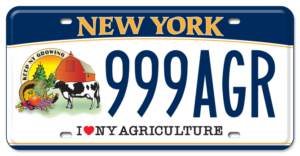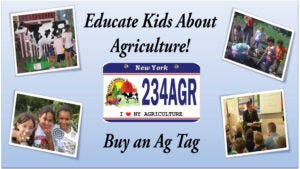New York, like many states around the country, puts the money earned from its agricultural specialty license plates toward New York Agriculture in the Classroom, educating students where their food and fiber come from. Emblazoned with “I Love NY Agriculture,” these plate feature a literal cornucopia of various farm and ranch products that are central to New York’s agricultural identity.
Older than most others, this specialty plate was originally established in 1985 and has gone through some iterations over the years. It is a partnership of Cornell University, the Department of Agriculture and Markets, the NYS Education Department, Cornell Cooperative Extension, and the New York Farm Bureau.
Adding the plates to your passenger or commercial vehicle costs $53.75, then $25 for subsequent renewals (personalized plates cost more). A portion of those fees support the New York Agriculture in the Classroom Fund, helping to increase ag literacy. Some of the programs these plates have helped include Kids Growing Food school garden grants, Agricultural Literacy Week, Food, Land & People Curriculum, an art and writing contest, “Moo Country” at the state fair, and educator workshops.

“Agriculture is vital to the health and well-being of all New Yorkers, and it is an essential component of our state’s economy,” DMV Commissioner Mark J.F. Schroeder told Lancaster Farming. “We at DMV recognize the importance of our agricultural sector and are proud to offer a license plate that supports agriculture education in our schools.”
New York Agriculture in the Classroom works with pre-K through middle school teachers, Cornell Cooperative Extension, farmers and many others in the community to help reach millions of young people.
“As our students are becoming further removed from the farm and agricultural production, our program is growing in necessity,” Katie Bigness, Coordinator of New York Agriculture in the Classroom said in a Cornell University newsletter. “The funds generated from the license plate allow us to train more teachers how to integrate agriculture into their curriculum, and allows hundreds of students the chance to participate in food production themselves through in‐school activities and school gardens.”
New York Farm Bureau said in an email to AGDAILY that it didn’t have records about how many different designs the plate had been through or what the funding was used for prior to its use with Ag in the Classroom. News reports show that Ag in the Classroom became the benefactor of the specialty plate in 2003.
The Empire State has more than 33,400 farms across 6.9 million acres. Hay and haylage account for the largest share of farmland in the state, while corn (with a $543 million value) and soybeans ($208 million value) are major players. The most valuable fruit crop is apples, at 1.3 billion pounds produced. Other notable crops in New York state include snap beans, sweet corn, maple syrup, oats, squash, pumpkins, and barley.
Ann Peck, Promotion and Education Chair of New York Farm Bureau, said in the Cornell newsletter, “The specialty New York license plate is just one more way people in this state can support their local farms. The Agriculture in the Classroom program serves to educate our young people about where their food comes and increases their appreciation of a way of life that benefits their communities in many ways.”



